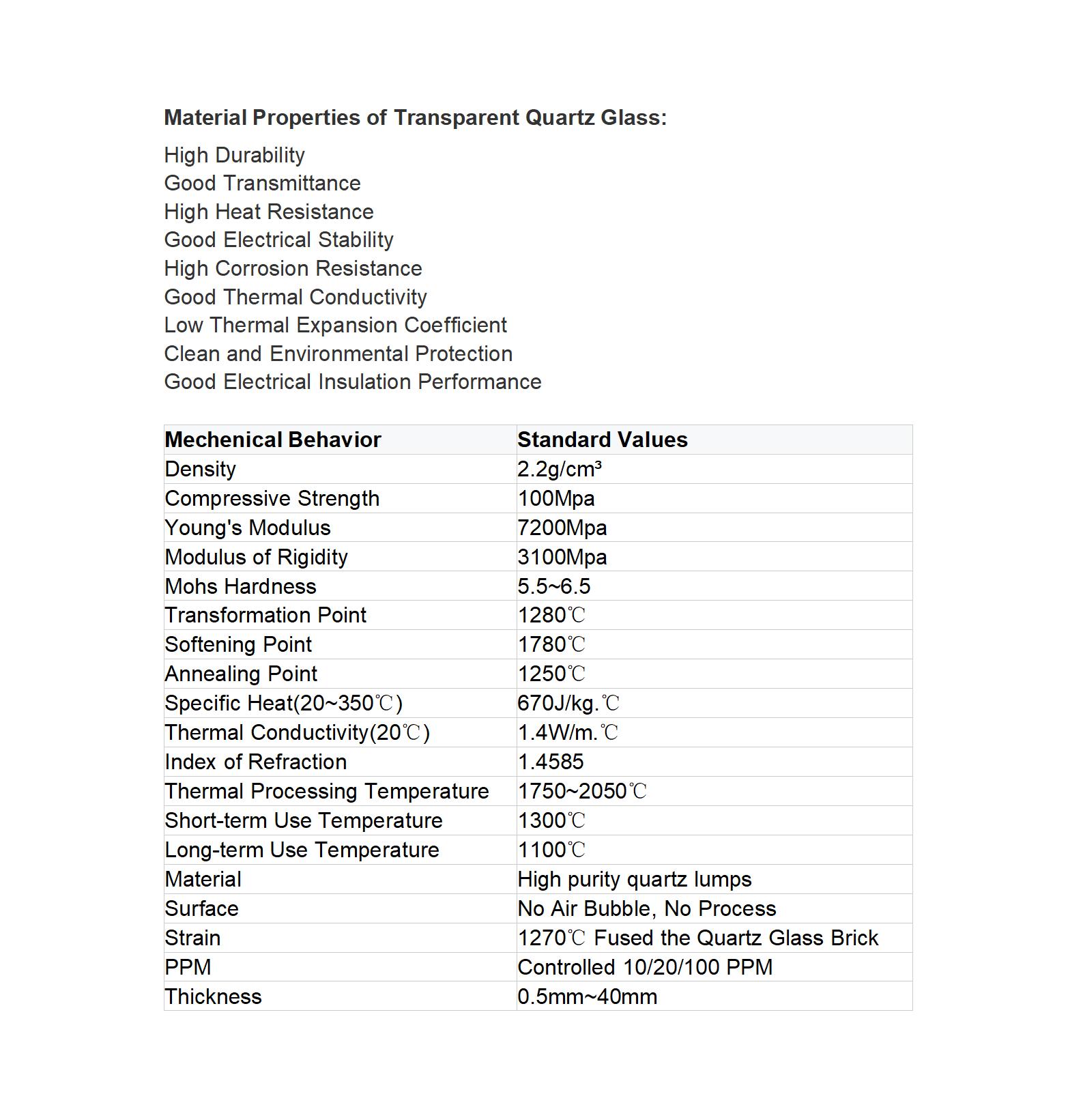T: +86-518-85528012
E: nick@luverrequartz.com
E: nick@luverrequartz.com
1st floor Runlian industrial center No. 116 QuFeng Rd., Haizhou Economic and technological development zone Lianyungang City, Jiangsu Province, China 222062
Wide spectrum quartz glass disc
Wide spectrum quartz glass disc is a special industrial technology glass made by melting high-purity natural quartz (such as crystal, quartz sand), mainly composed of silicon dioxide (SiO2).
LUVERRE quartz
99.99%
Inner with Vacuum PVC bag and then wrapped with air bubble film, outer with wooden box.
as per customer's requirement
| Availability: | |
|---|---|
Wide spectrum quartz glass disc
Wide spectrum quartz glass disc is a special industrial technology glass made by melting high-purity natural quartz (such as crystal, quartz sand), mainly composed of silicon dioxide (SiO2). This type of glass is renowned for its excellent physical and chemical properties, and is hailed as the "king of glass" by experts in the field of new materials. The structural characteristics of quartz glass are formed by tightly arranged tetrahedral units of silicon dioxide sharing oxygen atoms to form a continuous three-dimensional network. This amorphous structure gives quartz glass many unique physical and chemical properties, such as excellent spectral transparency, extremely low thermal expansion coefficient and conductivity, as well as excellent radiation resistance and long life under extreme conditions.

In the field of optics, wide spectrum quartz glass discs have excellent transmittance within a very wide spectrum from far ultraviolet (160nm) to far infrared (5 μ m), which is not possessed by general optical glasses. Due to its excellent spectral transmittance and optical uniformity, quartz glass is widely used in the field of optical devices. In addition, quartz glass has good radiation resistance and has been widely used as window material for spacecraft and protective cover for key components in space laboratories.
Quartz glass also has thermal shock resistance and can maintain stability under extreme temperature conditions. The commonly used temperature range is 1100-1200 ° C, and it can withstand high temperatures up to 1400 ° C in the short term. These characteristics make quartz glass widely used in high-end laboratory equipment, extraction devices for special high-purity products, and fields that require excellent optical performance glass.
According to their appearance and purity, quartz glass can be divided into two categories: transparent and opaque, as well as three categories: ordinary, high-purity, and doped. Ordinary quartz glass usually refers to quartz glass with low purity and a certain amount of impurities, while high-purity quartz glass refers to quartz glass with extremely high purity and low impurity content, which is usually used in applications that require high purity. Doped quartz glass refers to quartz glass in which specific additives (such as fluorides, metal oxides, etc.) are added during the preparation process to alter certain properties (such as refractive index, thermal expansion coefficient, etc.).

Wide spectrum quartz glass discs play an important role in various fields such as optics, semiconductors, aerospace, etc. due to their unique structure and properties.
Wide spectrum quartz glass disc
Wide spectrum quartz glass disc is a special industrial technology glass made by melting high-purity natural quartz (such as crystal, quartz sand), mainly composed of silicon dioxide (SiO2). This type of glass is renowned for its excellent physical and chemical properties, and is hailed as the "king of glass" by experts in the field of new materials. The structural characteristics of quartz glass are formed by tightly arranged tetrahedral units of silicon dioxide sharing oxygen atoms to form a continuous three-dimensional network. This amorphous structure gives quartz glass many unique physical and chemical properties, such as excellent spectral transparency, extremely low thermal expansion coefficient and conductivity, as well as excellent radiation resistance and long life under extreme conditions.

In the field of optics, wide spectrum quartz glass discs have excellent transmittance within a very wide spectrum from far ultraviolet (160nm) to far infrared (5 μ m), which is not possessed by general optical glasses. Due to its excellent spectral transmittance and optical uniformity, quartz glass is widely used in the field of optical devices. In addition, quartz glass has good radiation resistance and has been widely used as window material for spacecraft and protective cover for key components in space laboratories.
Quartz glass also has thermal shock resistance and can maintain stability under extreme temperature conditions. The commonly used temperature range is 1100-1200 ° C, and it can withstand high temperatures up to 1400 ° C in the short term. These characteristics make quartz glass widely used in high-end laboratory equipment, extraction devices for special high-purity products, and fields that require excellent optical performance glass.
According to their appearance and purity, quartz glass can be divided into two categories: transparent and opaque, as well as three categories: ordinary, high-purity, and doped. Ordinary quartz glass usually refers to quartz glass with low purity and a certain amount of impurities, while high-purity quartz glass refers to quartz glass with extremely high purity and low impurity content, which is usually used in applications that require high purity. Doped quartz glass refers to quartz glass in which specific additives (such as fluorides, metal oxides, etc.) are added during the preparation process to alter certain properties (such as refractive index, thermal expansion coefficient, etc.).

Wide spectrum quartz glass discs play an important role in various fields such as optics, semiconductors, aerospace, etc. due to their unique structure and properties.